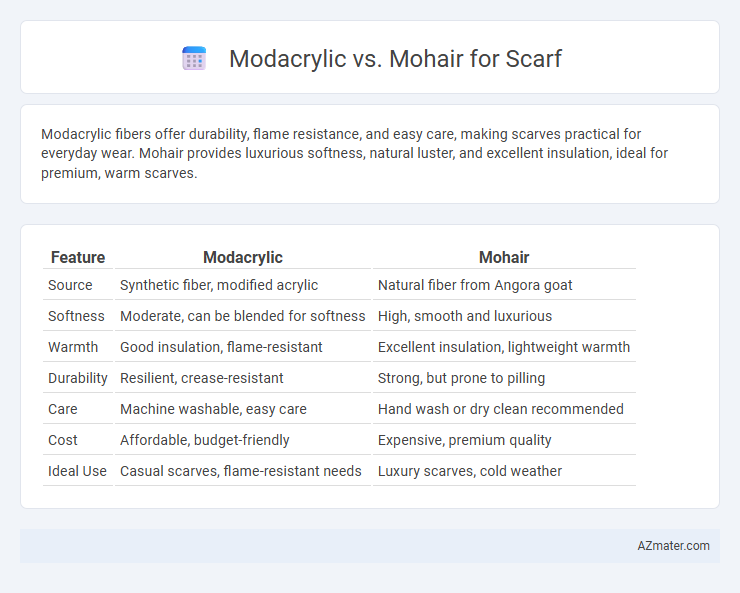Modacrylic fibers offer durability, flame resistance, and easy care, making scarves practical for everyday wear. Mohair provides luxurious softness, natural luster, and excellent insulation, ideal for premium, warm scarves.
Table of Comparison
| Feature | Modacrylic | Mohair |
|---|---|---|
| Source | Synthetic fiber, modified acrylic | Natural fiber from Angora goat |
| Softness | Moderate, can be blended for softness | High, smooth and luxurious |
| Warmth | Good insulation, flame-resistant | Excellent insulation, lightweight warmth |
| Durability | Resilient, crease-resistant | Strong, but prone to pilling |
| Care | Machine washable, easy care | Hand wash or dry clean recommended |
| Cost | Affordable, budget-friendly | Expensive, premium quality |
| Ideal Use | Casual scarves, flame-resistant needs | Luxury scarves, cold weather |
Introduction: Modacrylic vs Mohair Scarves
Modacrylic scarves offer durability, wrinkle resistance, and affordability, making them a practical choice for daily wear. Mohair scarves, made from the hair of the Angora goat, provide exceptional softness, sheen, and warmth, favored for luxurious comfort. Comparing Modacrylic and Mohair highlights differences in fiber origin, texture, care requirements, and price points essential for scarf selection.
What is Modacrylic?
Modacrylic is a synthetic fiber known for its softness, flame resistance, and easy care, making it a popular choice for scarves that require durability and warmth. Unlike mohair, which is derived from the Angora goat and offers natural luster and breathability, modacrylic provides excellent color retention and wrinkle resistance, ideal for vibrant and low-maintenance scarves. Choosing modacrylic scarves ensures a budget-friendly option with hypoallergenic properties, suitable for sensitive skin without compromising on comfort or style.
What is Mohair?
Mohair is a luxury fiber derived from the Angora goat, prized for its silky texture, natural sheen, and exceptional warmth. Compared to modacrylic, mohair is a natural animal fiber offering superior breathability, insulation, and durability, making it ideal for high-quality scarves. Its hypoallergenic properties and lightweight softness provide comfort while maintaining longevity, distinguishing mohair as a preferred choice in premium scarf materials.
Fiber Properties Comparison
Modacrylic fibers offer excellent flame resistance and durability, making them ideal for scarves that require easy care and long-lasting wear. Mohair, derived from the Angora goat, provides exceptional softness, natural luster, and superior moisture-wicking properties, enhancing comfort and luxury in scarf materials. While modacrylic scarves are resilient and hypoallergenic, mohair scarves excel in breathability and warmth, making each fiber suited for different functional and aesthetic preferences.
Warmth and Comfort: Which Is Better?
Modacrylic fibers provide excellent warmth and are inherently flame-resistant, making them a durable choice for scarves that retain heat even in damp conditions. Mohair, derived from the Angora goat, offers superior softness and breathability, creating a comfortable, luxurious feel against the skin while maintaining good insulation. For optimal warmth combined with comfort, mohair scarves tend to be preferred due to their natural fiber properties, though modacrylic scarves excel in durability and moisture resistance.
Durability and Longevity
Modacrylic fibers offer high durability and resistance to abrasion, making scarves made from this synthetic material long-lasting and easy to maintain. Mohair, derived from the Angora goat, boasts natural resilience and excellent elasticity, contributing to a scarf's longevity when properly cared for. While Mohair provides superior softness and insulation, Modacrylic excels in colorfastness and durability under frequent use.
Hypoallergenic Qualities
Modacrylic fibers are inherently hypoallergenic, making them ideal for scarves worn by individuals with sensitive skin or allergies, as they resist common irritants and allergens. Mohair, derived from the Angora goat, may cause irritation for allergy-prone wearers due to its natural lanolin content and fine scales that can trap allergens. Scarves made from modacrylic offer a safer option for hypoallergenic comfort without compromising warmth or softness.
Care and Maintenance
Modacrylic scarves require low maintenance, often being machine washable and resistant to shrinking or wrinkling, making them ideal for everyday wear. Mohair scarves demand delicate care, typically needing hand washing or dry cleaning to preserve their softness and prevent damage to the fine fibers. Proper storage for both materials involves keeping scarves in a cool, dry place away from direct sunlight to maintain their quality and appearance over time.
Cost and Accessibility
Modacrylic scarves generally offer a more affordable price point compared to luxurious mohair options, making them accessible for budget-conscious shoppers. Mohair scarves, derived from the hair of the Angora goat, command higher prices due to their natural fiber quality and exclusive sourcing. Accessibility is broad for modacrylic scarves as they are widely manufactured and available in mass-market outlets, whereas mohair scarves are often found in specialty boutiques and luxury retailers.
Which Scarf Material Should You Choose?
Modacrylic scarves offer excellent durability, wrinkle resistance, and ease of care, making them an ideal choice for everyday wear, while Mohair scarves provide superior warmth, softness, and a luxurious feel due to their natural goat hair fibers. Modacrylic excels in affordability and hypoallergenic properties, whereas Mohair is prized for its lightweight insulation and elegant appearance. Choosing between Modacrylic and Mohair depends on your priority for maintenance, softness, and budget, with Modacrylic suitable for practical use and Mohair preferred for premium comfort and style.

Infographic: Modacrylic vs Mohair for Scarf
 azmater.com
azmater.com